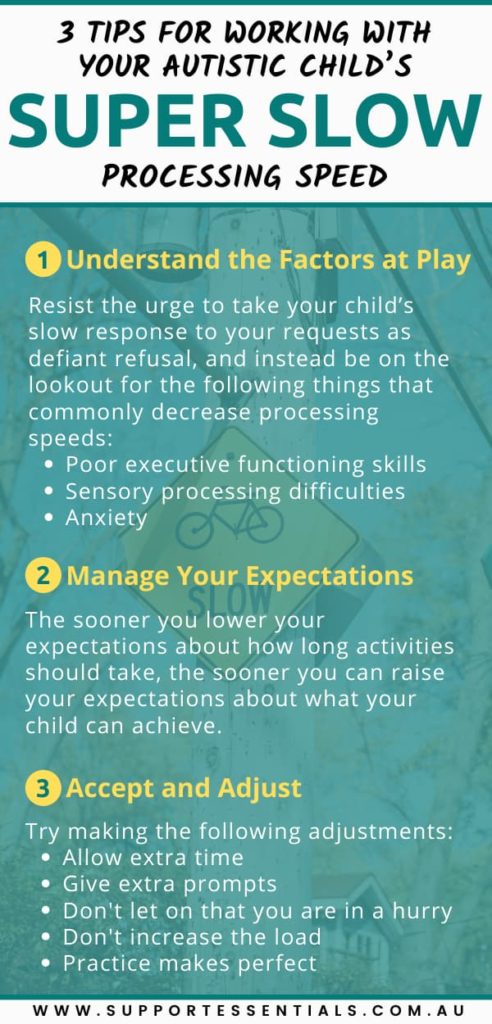Autism and Slow Processing Speed
I think all parents complain at one point or another that their children move at a snail’s pace.
Whether it’s kids dragging their feet in the morning getting ready for school, or cute little anecdotes about trying to get out of the house on time for a play date (the Bluey ‘Sticky Gecko’ episode is scarily accurate), kids slowing you down is generally considered part and parcel of being a parent.
But for those of us who parent Autistic children, there is an additional intensity to the level of slowness we experience – that of the slow processing speed.
Processing speed is the time it takes for an individual to gather information about the task at hand, think about it, determine the next action they wish to take, and then generate a result or produce a response.
Slow processing speeds are common among Autistic children.
Autism is a spectrum disorder, so everyone with Autism will not necessarily have a slow processing speed, but for those that do, a slow processing speed can affect a whole range of activities such as:
- Verbally answering a question
- Completing self-care activities (e.g. taking a bath, getting dressed, brushing teeth)
- Getting ready to leave the house
- Playing games and sports
- Completing school work and activities
Essentially, if you have a slow processing speed, it can delay any task you try to undertake, no matter how small.

How to Work with Your Autistic Child’s Slow Processing Speed
We live in a fast-paced world and there is a common expectation that tasks are completed quickly and efficiently. This can lead to extra stress and anxiety for those with slow processing speeds, as well as frustration for those of us with faster processing speeds.
Pressure, stress, anxiety and frustration can lead to explosive reactions to seemingly small and insignificant things. Dealing with your Autistic child’s slow processing speed may seem like an uphill battle, but the key is to work with it and not against it. There are lessons you can learn and strategies you can implement to help both you and your child.
Here are three useful things you can do.
1. Understand the Factors at Play
A lack of understanding about how or why your child’s processing speed is so slow can often lead to accusations of deliberate slowness and a sense that your child is being inconsiderate to you and the people around them.
This could not be further from the truth.
Resist the urge to take your child’s slow response to your requests as defiant refusal, and instead be on the lookout for the following things that commonly decrease processing speeds.
Poor Executive Functioning
Executive functioning refers to the activities our brain performs that allow us to manage our daily life.
If your child has poor executive functioning skills, they may struggle with planning, organising, managing time and recalling information they need to complete a task.
Poor executive functioning skills will slow your child’s processing speed considerably.
Read more about executive functioning.
Sensory Processing Difficulties
Be aware that your child’s processing speed can fluctuate.
It may seem to you that sometimes a task will be performed at normal speed, however at other times, or in other settings, the same task may take additional time to complete.
Sensory processing difficulties have the ability to bring your poor child’s brain to a screeching halt, even when completing tasks they perform regularly, or have performed well in the past.
Your child may display heightened or reduced sensitivity to sensory signals. This sensitivity can apply to any of the five commonly known senses (sight, sound, touch, taste and smell) as well as to the lesser known senses, vestibular and proprioception. Multiple senses may also be affected at the same time.
If the environment in which your child is trying to complete a task is aggravating these sensory sensitivities, their processing speed may decrease significantly.
Keep in mind that even tiny variations in an environment can upset someone with sensory processing difficulties.
Be on the lookout for these common culprits:
- Lighting – is it too bright or too dim?
- What is the ambient noise level? (Yes, it can be too quiet.)
- What material is the chair made of? Is it soft, prickly or smooth?
- Is there a smell wafting in from somewhere? (Even a nice smell can be distracting.)
- Are other objects or people too close or too far away?
Read more about sensory processing disorder.
Anxiety
Anxiety and a slow processing speed interact within a vicious circle. A slow processing speed may cause a child to feel anxious when they can’t respond within an appropriate time frame, and that anxiety, in turn, will also cause their processing speed to slow even further.
Read more about how anxiety and a slow processing speed interact.
2. Manage Your Expectations
If your child has a slow processing speed, then you may need to lower your expectations.
I want to be clear here. You don’t need to lower your expectations about what your child can do, but you do need to lower your expectations about how long it will take.
It’s important to note that even when a child’s processing speed is slow, it does not mean that child is necessarily intellectually slow or impaired. Your IQ can be above average, but your processing speed still slow.
Please do not dismiss a child who does not answer or respond in the expected timeframe as unable to complete the task or answer the question.
Hoping in vain that your child’s slow processing speed will somehow switch to normal with a bit of therapy or encouragement can lead to years of frustration for both parties.
The sooner you lower your expectations about how long activities should take, the sooner you can raise your expectations about what your child can achieve.

3. Accept and Adjust
Autism Spectrum Disorder is classified as a disability in Australia and with good reason.
All Autistic people will require a range of support throughout their lifetime in order to live their daily lives.
Accepting your child’s slow processing speed means making adjustments for it.
Here are some great places to start.
Allow Extra Time
This sounds like an obvious adjustment, but it can be hard to do because you are so used to calculating processing time based on your own processing speed, and not someone else’s.
Observing your child’s processing speeds for different activities and in different settings will soon give you insight into where you need some padding in your schedule.
One key area where people don’t realise they should allow extra time is when waiting for a verbal response.
Often, when a verbal question has had no response within the expected timeframe, we assume the question was not heard and we ask it again.
A child with a slow processing speed may be half way though processing their verbal answer, but when the question is repeated, it will interrupt that processing and they will have to start again. Continual repetition of the question will restart the brain over and over again and the question will never be answered and the child will become frustrated and upset.
If you are confident that your child has heard your question, allow up to 10 seconds for a response and don’t let siblings or other adults answer for them. 10 seconds of silence after a question has been asked can seem an excruciating amount of time, but you will find waiting quietly with an expectant posture will yield fantastic results.
Give Extra Prompts
As parents, we may experience frustration when forced to repeat ourselves over and over again.
However, if your child has a slow processing speed, you may find continual prompting becomes part of your daily life. Try to embrace it rather than loathe it.
Leave ample time between prompts to give your child a chance to process the request, an only re-prompt when it is obvious your child has lost their train of thought.
Visual schedules are a useful non-verbal prompt you can also use.
Don’t Let On That You Are In A Hurry
You have an appointment to get to and you should have been in the car five minutes ago. You can feel the urgency pulsing through your body.
It may seem like common sense to communicate to your child that they need to move things along because you have places to go and people to see, but this can backfire dramatically.
Standing over an Autistic child to hurry them up can cause anxiety. The urgency in your voice alone can bring them to a grinding halt.
Jumping in to help them complete their current task can make them lose their train of thought and they will have to start all over again from the beginning.
This is more likely to slow things down, rather than speed things up.
Instead, try keeping your tone of voice even and challenge them to a race. Or tickle them to get them energised and running towards the car.
Don’t Increase the Load
A brain, like a computer, can perform multiple tasks at once. But we all know what happens when we try to run too many apps at the one time – a computer becomes sluggish and slow.
Avoid multiple-part requests. It may be easier for you to ask your child to put on their school shoes, grab their school bag and jump in the car all in one sentence, but there is next to no chance your child with a slow processing speed will be able to process those requests as fast as you say them.
Communicating one instruction at a time greatly increases the chance of that instruction being carried out correctly and in a (relatively) timely manner.
Be aware that sensory responses to the environment can also add to the processing load of your child’s brain.
Simple things you may not notice, such as background noise or lingering smells, may take up a lot of processing space inside your child’s brain, leaving little room to process anything else.
Practice Makes Perfect
The good news is that you can undertake therapy to improve executive functioning skills and lessen anxiety and sensory processing difficulties. This in turn can have a positive effect on your child’s processing speed.
Talk to an Occupational Therapist about any concerns you may have about your child’s slow processing speed.

What do you think?
Has this article given you some ideas for better ways to respond to your child’s slow processing speed?
If you have any other helpful tips, share them in the comments below.





i am an adult with asd, and i experience slow processing. is there any way to taylor this information for adults with asd?
Hi Kirby,
Thanks for commenting. I’ll definitely consider writing a post for adults.
In the meantime, Autistic adults can still benefit from the ideas presented in this post by using them on themselves (as opposed to a parent using them on a child), and sharing them with friends and family to help them understand how your slow processing speed might hinder you in the moment, but will not stop you achieving great things overall.